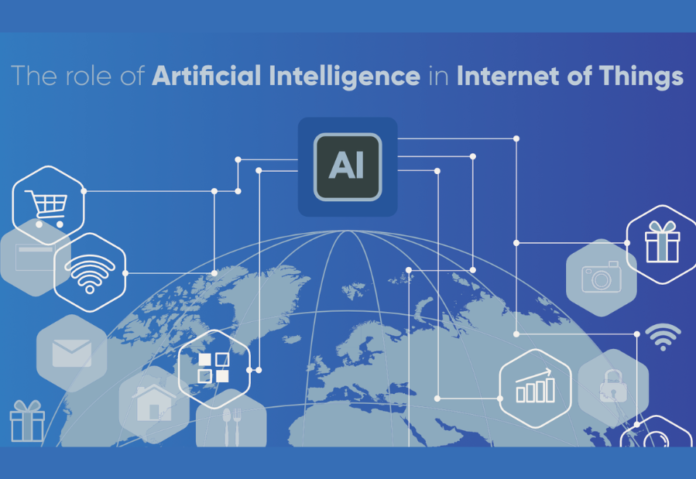The Internet of Things (IoT) and artificial intelligence (AI) are transforming how we utilize smart gadgets in daily life. IoT enables data sharing by connecting gadgets like wearables, automobiles, and household appliances to the internet. By examining the data, identifying trends, and coming to more intelligent conclusions, AI goes beyond this.
When combined, they provide more individualized, responsive, and efficient systems. This potent combination is influencing the direction of technology in a variety of fields, including healthcare, smart homes, and industrial automation.
In this blog, we’ll explore how AI enhances IoT and what it means for the future.
What is AI in IoT?
In the context of the Internet of Things, artificial intelligence (AI) is used to enhance the interoperability of linked devices. The Internet of Things, or IoT, allows objects to exchange and use data by connecting them to the internet. Examples of these devices include industrial sensors, wearable fitness trackers, and smart thermostats. IoT devices are improved by adding AI, which makes them smarter.
Smart systems that integrate AI and IoT are able to gather data, evaluate it, and make choices by themselves. For instance, a smart home system may automatically change the temperature or lighting based on your daily routine. This is made feasible via machine learning in the Internet of Things, whereby gadgets gradually enhance their performance by identifying patterns in data.
Industries including healthcare, agriculture, and transportation can develop smarter, more effective systems that save time and money while enhancing user experiences by fusing AI with IoT.
What is the intersection between AI and IoT?
The convergence of AI and IoT occurs when smart devices evaluate and respond to data gathered by IoT using Artificial Intelligence. While AI gives these gadgets the ability to learn, understand, and make decisions, IoT links gadgets like sensors, wearables, and appliances to exchange data. When combined, they provide more intelligent and effective systems that can enhance our day-to-day existence.
An excellent illustration of this junction is seen in AI-enabled smart gadgets. A smart speaker, for example, may learn your voice commands and preferences, allowing for more individualized interactions. AI can assist IoT-enabled devices in businesses in identifying issues early and proposing solutions before a breakdown occurs.
Smart cities, where AI controls traffic using IoT-connected sensors, and agriculture, where IoT devices monitor soil conditions and AI suggests the optimal planting dates, are two fascinating IoT uses of AI. Wearable health trackers that monitor vital indicators and notify clinicians in real time are just one example of how AI-driven IoT aids healthcare.
The capacity of AI-driven IoT to handle vast volumes of data from IoT devices and transform it into actionable steps is its greatest strength. These days, connecting gadgets isn’t enough; you also need to make them intelligent. There are countless opportunities at this confluence to turn residences, workplaces, and even entire cities into intelligent systems that effectively meet human requirements.
Benefits of AI in IoT
Smarter systems that benefit people, companies, and whole sectors are produced by integrating artificial intelligence (AI) with the Internet of Things (IoT). AI enhances IoT applications with better decision-making, efficiency, and customisation through the analysis of data from connected devices.
Here are some of the key benefits
1. Improved Data Analysis : Massive volumes of data are produced by IoT devices, but processing and interpreting this data is challenging without artificial intelligence. Artificial intelligence (AI) analyzes data more quickly and precisely, seeing patterns and trends that people would overlook. IoT sensors, for instance, may track weather and soil conditions in agriculture. AI gives farmers useful information, such as when to irrigate or grow crops.
2. Automation : IoT systems may now carry out activities autonomously without human assistance thanks to AI. Errors are decreased and time is saved. A smart thermostat, for example, may automatically change the temperature based on your preferences. IoT systems driven by AI may monitor equipment and carry out predictive maintenance in industrial settings, decreasing downtime and increasing output.
3. Enhanced Personalization : IoT devices may adjust to user preferences thanks to AI. Wearable fitness trackers, for instance, may evaluate your daily activities and suggest customized training regimens. Similar to this, AI-driven assistants and other smart home appliances may learn your habits and provide personalized recommendations, improving the convenience of daily living.
4. Increased Efficiency : Systems become more efficient when AI’s intelligence and IoT’s connection are combined. IoT sensors, for instance, can track the position and state of items in logistics, and artificial intelligence (AI) can optimize delivery routes to save time and fuel. In order to improve energy distribution and save waste, smart grids employ artificial intelligence (AI) to evaluate data from IoT-connected meters.
5. Real-Time Decision-Making : Real-time data collection from IoT devices may be instantaneously evaluated using AI to enable prompt decision-making. Wearable medical technology tracks vital signs and uses artificial intelligence (AI) to identify anomalies, promptly notifying physicians. AI can evaluate traffic information from Internet of Things sensors to modify traffic signals in smart cities, which would lessen congestion.
6. Predictive Maintenance : Predictive maintenance is one of the most important advantages in enterprises. Data on equipment performance is gathered by IoT sensors, and AI evaluates this data to forecast when a machine may break. This saves money and increases dependability by enabling businesses to address problems before they become serious ones.
7. Enhanced Security : AI can improve the security of IoT devices, which are frequently the target of hackers. AI is able to predict possible hazards and take action to stop them by seeing odd patterns in data or behavior. AI-powered security cameras, for instance, are able to identify questionable activities and notify companies or homes.
8. Scalability : It is harder to manage the growing number of linked devices as IoT networks expand. AI facilitates seamless operation even as systems grow by automating procedures. In sectors like manufacturing and smart cities, where hundreds of devices must cooperate flawlessly, this is very helpful.
Conclusion:
Devices are becoming smarter, quicker, and more efficient thanks to the convergence of AI and IoT. There are several advantages and applications for this technology, ranging from smart cities and homes to healthcare and agriculture. To realize its full potential, however, issues like complexity, high prices, and data privacy must be resolved.






